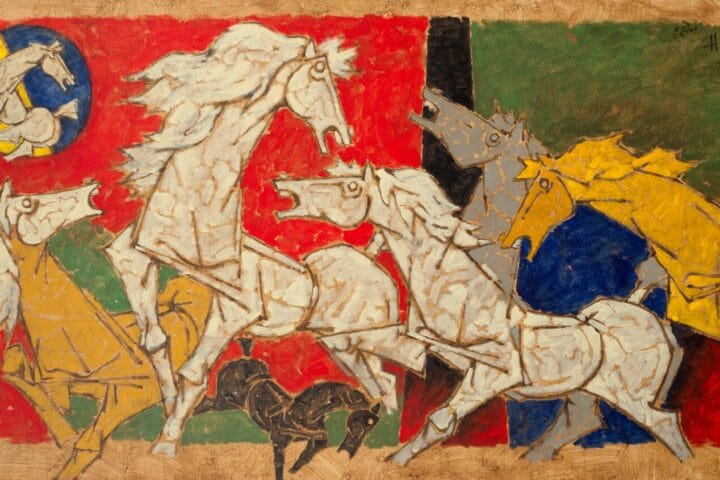The Modern Woman presents works by twelve groundbreaking Finnish women artists and highlights their substantial contribution to 20th century modernism. It brings together over 150 works by artists including Hilda Flodin, Sigrid Schauman, Helene Schjerfbeck, Elga Sesemann and Ellen Thesleff, who developed new visual languages and adopted radical approaches to painting and sculpture – outpacing male artists in introducing them to Finland’s cultural realm. Set amid seismic changes to the social, political and cultural landscape of the late 19th and early 20th centuries, the exhibition examines their works from two angles: looking at women as both the creators and the subject of their images.
Spanning painting, sculpture, drawing and prints, The Modern Woman reflects the position of women in Finland during the period. One of the first countries to give women the right to vote in 1906, they were also able attend art school, access grants and travel internationally, enabling them to pursue independent careers as artists for the first time. The exhibition embodies the radical spirit that united these women: the dedication to their profession, their drive to seize opportunities for artistic self-development, and their rejection of the lifestyle expected of them.
Throughout their lives these women worked internationally in the artistic centres of Europe such as Paris and Florence. This influenced their work and is reflected in the choice of subject matter and techniques. Early paintings by Ellen Thesleff reveal the influence of Impressionism and Expressionism; she later formed Finland’s Septem group, which introduced Impressionism to the country. Helene Schjerfbeck’s paintings also demonstrate the wide range of sources available to artists working in the French capital. A teacher of Ellen Thesleff among others, the exhibition reveals how these artists often inspired and supported each other throughout their careers.
The exhibition also features the bronze sculpture Old Man Thinking, 1900 by Hilda Flodin, who trained as Rodin’s assistant. Embracing the famously erotic quality of Rodin’s work both as sculptor and sitter, Flodin’s work demonstrates how women artists began to permeate the roles and genres traditionally considered the domain of men.
As the drive for emancipation and demands for equality progressed, the image of a woman began to assume unfamiliar nuances in the artists depictions of themselves and other women. Alongside passive beauty and an erotic charge, the images contained more complex, less idealised and more mundane characteristics. New subjects might be working women or often the artist herself. Helene Schjerfbeck is renowned for her self-portraits but her paintings of modern women includes The Teacher, 1933 and Nurse I, 1943. Sigrid Schauman experimented with many styles and techniques throughout her career and her minimalistic female nudes, such as Model, 1958 are almost ethereal studies in light and colour, despite their clear corporeality and thick layers of paint.
The work of a prior generation of pioneering artists was continued by Elga Sesemann, a bold colourist influenced by German expressionism, surrealism and metaphysical art. Like Schjerfbeck, Thesleff and Schauman, Sesemann created several self-portraits using a palette knife, examining herself with an unsentimental and psychologically astute eye.
The works in The Modern Woman show how despite being forced to contend with expectations and restrictions due to their gender, these women were able to forge independent careers as artists and go on to play a crucial role in the development of art in Finland and beyond.
Dialogue: Elina Brotherus and Hannele Rantala
11 February – 27 March 2022
Dialogue features works by Finnish photographers Elina Brotherus (b. 1972) and Hannele Rantala (b. 1952) who, alongside their independent practices, have been making work in dialogue together for over two decades. Through this tandem creative approach, Brotherus and Rantala offer their individual reflections on identity and the role and status of women artists in today’s world.
Typical of the duo’s working method, the photographs in the exhibition have been made in response to themes, quotes and assignments that the artists have set each other. The new works created in response to these assignments reflect each of the artists’ particular styles: while Brotherus is noted for her witty self-portraiture and autobiographical references, Rantala takes a more poetic approach. Taken together, the works are a celebration of individual expression, reflecting on personal experiences and the subjective nature of art and creativity.
Assignments include tasks based on quotes by Yoko Ono and Erwin Wurm’s one-minute sculptures. One of the assignments that recurs throughout the exhibition is ‘Choose works by forgotten female photographers and make a parallel work’: this sees the duo take inspiration from a variety of unknown or forgotten women creatives across literature and the arts, from Nordic poet Edith Södergran to photographers such as Hilja Ravinemi and Emmi Fock. The exhibition sees Brotherus and Rantala questioning the canon while honouring the influence and importance of women artists.
About Ateneum Art Museum, Finnish National Gallery:
Ateneum is Finland’s leading national art museum, located in the heart of Helsinki it houses the biggest collection of classical art in Finland. Ateneum is one of the three museums forming the Finnish National Gallery, alongside Museum of Contemporary Art Kiasma and Sinebrychoff Art Museum.










